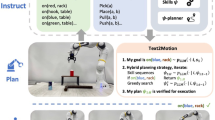Abstract
Reaching and grasping an object can be viewed as the solution of a multiple-constraint satisfaction problem. The constraints include contact with the object with the appropriate effectors in the correct positions as well as generation of a collision-free trajectory. We have developed a computational model that simulates reaching and grasping based on these notions. The model, rendered as an animation program, reproduces many basic features of the kinematics of human reaching and grasping behavior. The core assumptions of the model are: (1) tasks are defined by flexibly organized constraint hierarchies; (2) manual positioning acts, including prehension acts, are first specified with respect to goal postures and then are specified with respect to movements towards those goal postures; (3) goal postures are found by identifying the stored posture that is most promising for the task, as determined by the constraint hierarchy, and then by generating postures that are more and more dissimilar to the most-promising stored posture until a deadline is reached, at which time the best posture that was found during the search is defined as the goal posture; (4) depending on when the best posture was encountered in the search, the deadline for the search in the next trial is either increased or decreased; (5) specification of a movement to the goal posture begins with straight-line interpolation in joint space between the starting posture and goal posture; (6) if an internal simulation of this default movement suggests that it will result in collision with an obstacle, the movement can be reshaped until an acceptable movement is found or until time runs out; (7) movement reshaping occurs by identifying a via posture that serves as a body position to which the actor moves from the starting posture and then back to the starting posture, while simultaneously making the main movement from the starting posture to the goal posture; (8) the via posture is identified using the same posture-generating algorithm as used to identify the goal posture. These processes are used both for arm positioning and, with some elaboration, for prehension. The model solves a number of problems with an earlier model, although it leaves some other problems unresolved.
Similar content being viewed by others
Author information
Authors and Affiliations
Additional information
Received: 20 September 1998 / Accepted: 10 March 1999
Rights and permissions
About this article
Cite this article
Rosenbaum, D., Meulenbroek, R., Vaughan, J. et al. Coordination of reaching and grasping by capitalizing on obstacle avoidance and other constraints. Exp Brain Res 128, 92–100 (1999). https://doi.org/10.1007/s002210050823
Issue Date:
DOI: https://doi.org/10.1007/s002210050823




